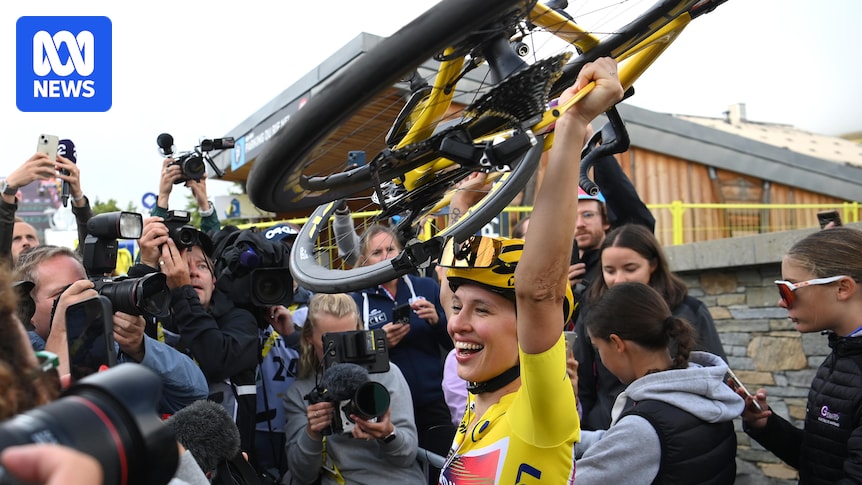
Four seconds may not seem like a lot of time, yet at the conclusion of the third edition of the Tour de France Femmes, those four seconds encapsulated the universe between the unbridled joy of victory and the unadulterated pain of defeat. Poland’s Katarzyna Niewiadoma edged out defending champion Demi Vollering by just four seconds—a margin so small it marked the closest finish in grand tour history, men’s or women’s.
The Polish rider’s gutsy climb up the vaunted Alpe d’Huez to limit her losses to Vollering—whose own efforts through the famous switchbacks were just as impressive—will go down in cycling folklore. The mist, the desperation, the agonizing wait for confirmation; it was a final stage that contained all the ingredients of a classic that duly delivered.
The Forgotten Femmes
This year’s edition is being billed as the fourth of the Tour de France Femmes, but that’s not entirely true. The first-ever women’s Tour de France took place in 1955, when 41 riders completed five stages of racing, with Manx rider Millie Robinson taking out the overall prize. Then, another long delay until 1984, when American rider Marianne Martin claimed overall honors in the first Tour de France Féminin, a race missing many stars due to the first-ever women’s Olympic road race, which took place at the same time.
She stood on the final podium in Paris, alongside men’s champion Laurent Fignon, who raised her arm in the air, a scene repeated every year until 1989. This was, on the face of it, as close to equality as women’s cycling would get in relation to the Tour de France. The rest of the decade was dominated by the two biggest stars in the women’s peloton, Italian Maria Canins and Frenchwoman Jeannie Longo.
As chronicled in the SBS-screened documentary, Breakaway Femmes, women raced in national teams on the same roads as the men’s race, on the same day—the women would race in the morning, the men following afterwards. Despite massive crowds enjoying the racing, women being involved in the Tour was not without its critics.
“The professionals didn’t like us coming to their Tour de France,” Longo said. “They were known as ‘giants of the road’, so the idea of women climbing Alpe d’Huez or Izoard, it would destroy their myth.”
The ‘Ugly’ Race with a Prize for Elegance
Legendary commentator Phil Liggett said in the documentary, “I don’t think the world was ready for the first women’s Tour de France.” In archive footage from the race, he talks about “the chauvinistic gap” in prize money while interviewing his wife Pat, who was director sportif of the British team. Women interviewed for the documentary noted that the coverage for the women was still a tiny fraction of what was given to the men, who were all professional, whereas the women were all amateur.
While men were awarded the Combativity award for the most exciting racing each day, women in the race were awarded the elegance prize. The prize was a shopping spree in Paris. Kelly-Ann Way, understandably, described it as “demeaning”.
“The media was saying that the women won’t finish, they’ll be crying, they’re too fragile,” Canadian cyclist Kelly-Ann Way said. “It was fun proving them wrong.”
The Closest Grand Tour in History
Despite such an impressive yet troubled backstory, the 2024 edition of the Femmes was a fitting addition to the annals of the world’s greatest and most famous race. Vollering had taken the yellow jersey after winning the stage 3 time trial on her home roads of the Netherlands. But, on stage 5, a flat sprinters’ stage into Amnéville, she crashed just 6.5km from the finish.
Clearly hampered by what later turned out to be a broken tailbone, Vollering remounted and did her utmost to limit her losses en route to the finish. However, not one of her SD Worx teammates came back to help her, an issue that still rankles, and felt like “a slap in the face” by the defending champion.
“So kind of the bunch to make the decision not to use this crash of @tadejpogacar to take time on him,” Vollering wrote on her Instagram story. “Guess men are a bit more kind.”
Looking Ahead to 2025
Vollering has since moved on from the team, joining FDJ-Suez where she will hope to regain the title in this year’s edition, which, like the men’s race, heads out of Brittany and cuts across the country to finish at Châtel on the Swiss border. There are nine stages, covering 1,165km of road with 17,240m of elevation gain over the nine days. Two of those stages are mountainous—the feature 8th stage, including a trip up the legendary Col de la Madeleine.
Her stiffest opposition to victory may well come from the subtly-renamed SD Worx-Protime, with runner-up in 2023 and reigning world champion Lotte Kopecky set to challenge as leader of her former team. Kopecky is far more suited to one-day races, but is far from a lump in the mountains, and has dropped her weight a fraction to better handle the mountain climbs.
But then there’s Anna van der Breggen, two-time former world champion and the team’s ex-director sportif, who is back out of retirement and will be an option as well, with the team also hunting stage wins with Dutch national champion Lorena Wiebes and Blanka Vas.
Speaking of the greats, arguably the greatest all-round cyclist in history, Pauline Ferrand-Prévot will be carrying the host nation’s hopes. The 33-year-old has won world titles in cyclo-cross, gravel and on the road, as well as winning 12 world championships in various mountain bike disciplines, capped by winning Olympic gold in Paris last year.
Sarah Gigante: A Genuine Chance
Can any Aussies challenge? Neve Bradbury, Brodie Chapman, Amanda Spratt, Sarah Gigante, Ruby Roseman-Gannon, Lucie Fityus, and Emily Watts are set to start the race, but one name stands out above all others. Gigante of AG Insurance-Soudal had a brilliant Giro d’Italia Donne, finishing in third place, just 1 minute 11 seconds behind overall winner, Elisa Longo Borghini.
By winning both mountain stages, Gigante won the mountains jersey in a breakout performance from the 24-year-old. Incredibly, it could have been even better. Had Gigante not lost 1 minute and 42 seconds in crosswinds on the sixth stage, she could conceivably have won the title and catapulted herself into the conversation as one of the favorites for multiple grand tours to come.
This all after an interrupted summer where she needed major surgery after being struck down by iliac artery endofibrosis. Is this young Victorian a smoky for a podium at the Femmes? You can’t rule her out.







